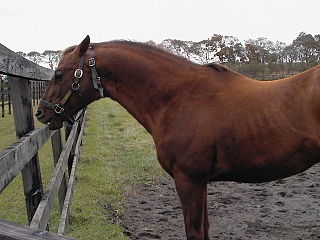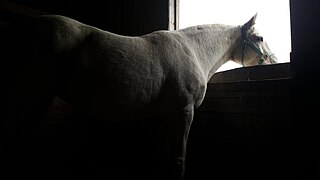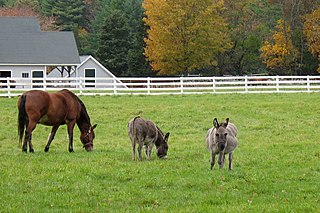
Trait ascription bias is the tendency for people to view themselves as relatively variable in terms of personality, behavior and mood while viewing others as much more predictable in their personal traits across different situations. More specifically, it is a tendency to describe one's own behaviour in terms of situational factors while preferring to describe another's behaviour by ascribing fixed dispositions to their personality. This may occur because peoples' own internal states are more readily observable and available to them than those of others.
Psychopathology is the study of abnormal cognition, behaviour and experiences which differs according to social norms and rests upon a number of constructs that are deemed to be the social norm at any particular era.
A stereotypy is a repetitive or ritualistic movement, posture, or utterance. Stereotypies may be simple movements such as body rocking, or complex, such as self-caressing, crossing and uncrossing of legs, and marching in place. They are found especially in people with autism spectrum disorders and visually impaired children, and are also found in intellectual disabilities, tardive dyskinesia and stereotypic movement disorder, yet may also be encountered in neurotypical individuals as well. Studies have shown stereotypies associated with some types of schizophrenia. Frontotemporal dementia is also a common neurological cause of repetitive behaviors and stereotypies. Several causes have been hypothesized for stereotypy, and several treatment options are available.
An ethogram is a catalogue or inventory of behaviours or actions exhibited by an animal used in ethology.

Cribbing is a form of stereotypy (equine oral stereotypic behaviour), otherwise known as wind sucking or crib-biting. Cribbing is considered to be an abnormal, compulsive behavior seen in some horses, and is often labelled a stable vice. The major factors that cause cribbing include stress, stable management, genetic and gastrointestinal irritability.

Weaving is a behaviour in horses that is classified as a stable vice, in which the horse repetitively sways on its forelegs, shifting its weight back and forth by moving the head and neck side to side. It may also include swaying of the rest of the body and picking up the front legs. Some horses exhibit non-stereotypical weaving, and instead engage in variations on this behavior.
Stereotypic movement disorder (SMD) is a motor disorder with onset in childhood involving restrictive and/or repetitive, nonfunctional motor behavior, that markedly interferes with normal activities or results in bodily injury. To be classified as SMD, the behavior in question must not be due to the direct effects of a substance, autism, or another medical condition. The cause of this disorder is not known.

Animals that are held by humans and prevented from escaping are said to be in captivity. The term is usually applied to wild animals that are held in confinement, but may also be used generally to describe the keeping of domesticated animals such as livestock or pets. This may include, for example, animals in farms, private homes, zoos and laboratories. Animal captivity may be categorized according to the particular motives, objectives and conditions of the confinement.

Behavioral enrichment is an animal husbandry principle that seeks to enhance the quality of captive animal care by identifying and providing the environmental stimuli necessary for optimal psychological and physiological well-being. Enrichment can either be active or passive, depending on whether it requires direct contact between the animal and the enrichment. A variety of enrichment techniques are used to create desired outcomes similar to an animal's individual and species' history. Each of the techniques used are intended to stimulate the animal's senses similarly to how they would be activated in the wild. Provided enrichment may be seen in the form of auditory, olfactory, habitat factors, food, research projects, training, and objects.

Stable vices are stereotypies of equines, especially horses. They are usually undesirable habits that often develop as a result of being confined in a stable with boredom, hunger, isolation, excess energy, or insufficient exercise. They present a management issue, not only leading to facility damage from chewing, kicking, and repetitive motion, but also leading to health consequences for the animal if not addressed. They also raise animal welfare concerns.
Animal psychopathology is the study of mental or behavioral disorders in non-human animals.

Some of the research that is conducted in the field of psychology is more "fundamental" than the research conducted in the applied psychological disciplines, and does not necessarily have a direct application. The subdisciplines within psychology that can be thought to reflect a basic-science orientation include biological psychology, cognitive psychology, neuropsychology, and so on. Research in these subdisciplines is characterized by methodological rigor. The concern of psychology as a basic science is in understanding the laws and processes that underlie behavior, cognition, and emotion. Psychology as a basic science provides a foundation for applied psychology. Applied psychology, by contrast, involves the application of psychological principles and theories yielded up by the basic psychological sciences; these applications are aimed at overcoming problems or promoting well-being in areas such as mental and physical health and education.

Behavioural genetics, also referred to as behaviour genetics, is a field of scientific research that uses genetic methods to investigate the nature and origins of individual differences in behaviour. While the name "behavioural genetics" connotes a focus on genetic influences, the field broadly investigates the extent to which genetic and environmental factors influence individual differences, and the development of research designs that can remove the confounding of genes and environment. Behavioural genetics was founded as a scientific discipline by Francis Galton in the late 19th century, only to be discredited through association with eugenics movements before and during World War II. In the latter half of the 20th century, the field saw renewed prominence with research on inheritance of behaviour and mental illness in humans, as well as research on genetically informative model organisms through selective breeding and crosses. In the late 20th and early 21st centuries, technological advances in molecular genetics made it possible to measure and modify the genome directly. This led to major advances in model organism research and in human studies, leading to new scientific discoveries.

Psychology encompasses a vast domain, and includes many different approaches to the study of mental processes and behavior. Below are the major areas of inquiry that taken together constitute psychology. A comprehensive list of the sub-fields and areas within psychology can be found at the list of psychology topics and list of psychology disciplines.

In animal behaviour, stereotypy, stereotypical or stereotyped behaviour has several meanings, leading to ambiguity in the scientific literature. A stereotypy is a term for a group of phenotypic behaviours that are repetitive, morphologically identical and which possess no obvious goal or function. These behaviours have been defined as ‘abnormal’ as they exhibit themselves solely to animals subjected to barren environments, scheduled or restricted feedings, social deprivation and other cases of frustration, but do not arise in ‘normal’ animals in their natural environments. These behaviours may be maladaptive, involving self-injury or reduced reproductive success, and in laboratory animals can confound behavioural research. Stereotypical behaviours are thought to be caused ultimately by artificial environments that do not allow animals to satisfy their normal behavioural needs. Rather than refer to the behaviour as abnormal, it has been suggested that it be described as "behaviour indicative of an abnormal environment."

Abnormal behavior of birds in captivity has been found to occur among both domesticated and wild birds. Abnormal behavior can be defined in several ways. Statistically, 'abnormal' is when the occurrence, frequency or intensity of a behaviour varies statistically significantly, either more or less, from the normal value. This means that theoretically, almost any behaviour could become 'abnormal' in an individual. Less formally, 'abnormal' includes any activity judged to be outside the normal behaviour pattern for captive birds of that particular class or age. For example, running rather than flying may be a normal behaviour and regularly observed in one species, however, in another species it might be normal but becomes 'abnormal' if it reaches a high frequency, or in another species it is rarely observed and any incidence is considered 'abnormal'. This article does not include 'one-off' behaviours performed by individual birds that might be considered abnormal for that individual, unless these are performed repeatedly by other individuals in the species and are recognised as part of the ethogram of that species.
Toe pecking, an abnormal behaviour of birds in captivity, occurs when one bird pecks the toes of another using its beak. This behaviour has been reported in hens and ostriches. Studies have shown that hens exposed to toe pecking have significantly enlarged adrenal glands, indicating increased physiological stress. Hens exposed to toe pecking will step off a raised platform more quickly than control hens, possibly suggesting a heightened fear of elevation. They have also been reported to show depressive behaviour when afflicted by toe-pecking. The act of toe pecking leads to open wounds which are viable for infection and disease to develop. In severe forms, toe pecking can be classified as a cannibalistic behaviour and has been reported as a cause of mortality.

Research into the mental disorder of schizophrenia, involves multiple animal models as a tool, including in the preclinical stage of drug development.
Developmental homeostasis is a process in which animals develop more or less normally, despite defective genes and deficient environments. It is an organisms ability to overcome certain circumstances in order to develop normally. This can be either a physical or mental circumstance that interferes with either a physical or mental trait. Many species have a specific norm, where those who fit that norm prosper while those who don't are killed or find it difficult to thrive. It is important that the animal be able to interact with the other group members effectively. Animals must learn their species' norms early to live a normal, successful life for that species.








